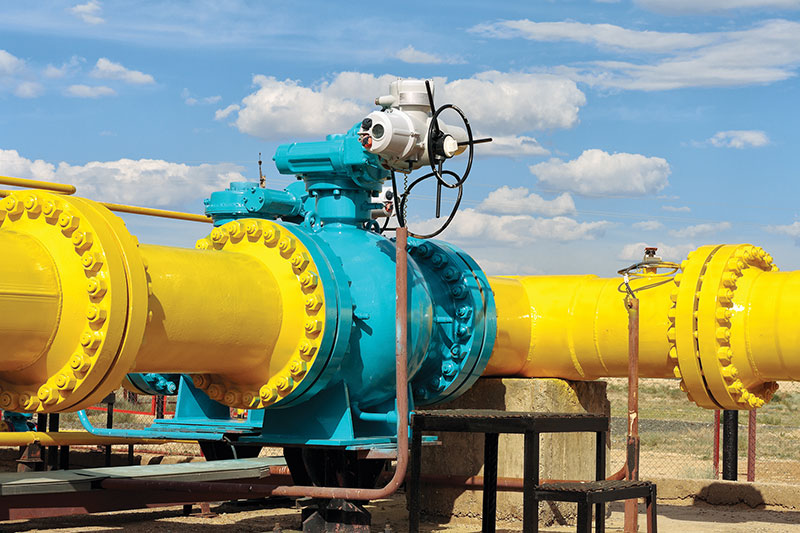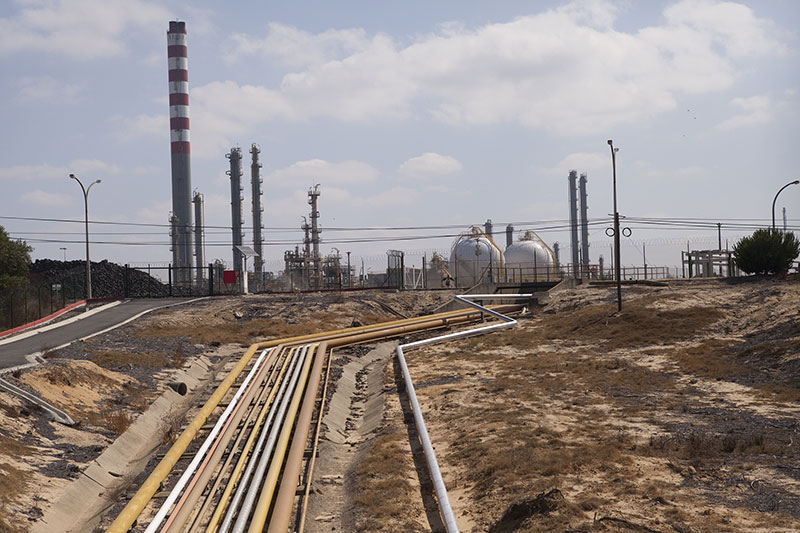October 2021, Vol. 248, No. 10
Features
Methane Initiatives Place Emphasis on Rounding Up Fugitives

By Richard Nemec, Contributing Editor
In late summer as Congress debated the Biden administration’s trillion-dollar infrastructure legislation, Microsoft founder Bill Gates added some skin in the game with a $1.5 billion pledge to support a joint venture with the U.S. Department of Energy (DOE) to accelerate clean energy technologies, including ways to better identify and contain methane emissions.
If the bipartisan infrastructure package passes and is signed into law, Gates is prepared to throw in his money for attempts to slow down climate change.
Gates and two dozen other billionaires, through the Breakthrough Energy Ventures Catalyst project, plan to invest the money over three years in public-private partnerships to boost technology demonstrations for sustainable aviation fuel, green hydrogen, direct air capture and energy storage.
“If the Infrastructure Investment and Jobs Act becomes law, this collaboration will not only send us on a more durable path to net zero, it will create both immediate and long-term jobs in communities across the country,” Gates said.
At the same time, more than 45 natural gas companies through their ONE Future Coalition are working to voluntarily reduce methane emissions across the gas value chain to 1% (or less) by 2025.

The group effort boasts some of the largest U.S. gas production, gathering, processing, transmission and storage/distribution companies, representing more than 15% of the U.S. gas value chain. In 2019 the coalition registered a methane intensity number of 0.334%, beating its 1% goal by 67% and “demonstrating that the natural gas industry can minimize methane emissions and increase production and throughput while supplying much needed energy for years to come,” according to the American Gas Association (AGA).
One of the methane-reducing technologies that will be displayed at the fall AGA national meeting comes from Bend, Oregon-based Onboard Dynamics’ GoVAC Flex, a patented system for reducing methane discharges. Onboard engineers call it a “simple, mobile, fully integrated solution” providing operators of natural gas pipelines with a tool to safely minimize their greenhouse gas (GHG) emissions during routine pipeline maintenance.
It’s a technology based on a platform that is both mobile, and modular, allowing operators to “responsibly manage and use natural gas,” according to Onboard. “The innovative products based on this platform enable customers to achieve economic value and environmental benefits by simplifying the compression and transfer of natural gas.” Founded in 2013, Onboard Dynamics bills itself as specialists in gas compression technologies.
Seriously cutting methane emissions in a still fossil fuel-dependent world requires greater amounts and more accurate data, and that remains a challenge. Having more accurate emissions factors for each piece of gas equipment or mile of pipe is important.
These factors are the product of past scientific studies, one key study dating back nearly 30 years to when industry researchers and the U.S. Environmental Protection Agency (EPA) examined the entire gas value chain.
“Anyone using the old emissions factors now is probably overestimating the emissions, since companies have done a lot to reduce methane since then,” said Pamela Lacey, AGA’s chief regulatory counsel.
“Recent studies provide a more up-to-date picture,” Lacey said. “EPA has included some newer emission factors from these studies to estimate nationwide emissions in the annual U.S. inventory.”
Lacey said the next step is to revise the Subpart W methane reporting rule to allow individual companies to use the updated emissions factors to report company emissions. Going forward, she thinks there is interest in allowing companies to do their own measurements to provide a more accurate company-specific emissions factor estimate – to better demonstrate actual progress in reducing emissions.
The largest source of methane comes from farm animals (enteric fermentation or “cows burping”), followed by natural gas systems, landfills, manure management, wastewater treatment and other sources.
This amounts to about 10% of the greenhouse gas (GHG) emissions, with natural gas systems representing a little more than a quarter of the 10%. AGA Analyst Gina DeFrancesco concluded in an issues paper that EPA’s reported U.S. trend for declining methane emissions will continue based on continuing improvements in technology, ongoing science and understanding of the EPA trends.
Nevertheless, she acknowledges that three years ago EPA revised upward the methane emissions estimates by 20% based on a revision of year-end 2018 data, with a large one-time increase in estimated emissions from commercial and industrial gas users.
As with climate change, methane emissions are a global issue, and the oil/gas industry is a major source of the overall worldwide concentrations of methane, which are estimated to be two-and-a-half times greater than pre-industrial levels, according to the International Energy Agency’s (IEA) ongoing monitoring, dubbed the “Methane Tracker.”
Methane concentrations are increasing steadily around the world, IEA noted, while acknowledging that emissions estimates are subject to “a high degree of uncertainty.”

About 60% of the methane released into the atmosphere comes from human activity (anthropogenic emissions). The rest (40%) comes from various natural sources. A quarter of the man-made emissions are caused by agriculture with the next largest portion tied to the energy sector (oil, gas, coal and biofuels). IEA’s “global methane budget” estimates the annual global emissions of methane are around 570 million metric tons (Mt). The methane budget “synthesizes results from top-down studies and bottom-up estimates to provide global statistics on methane emissions from 2008 to 2017,” according to IEA.
Respected international commentator Fareed Zakaria writing in the Washington Post in August quoted everyone from St. Augustine to President Biden in concluding that U.S. energy policy is conflicted and ineffective.
“The White House [has] illustrated the central reason U.S. energy policy is failing. It promises that we can get to a carbon-free future without imposing real costs on the American people, and without having to make some very difficult trade-offs,” Zakaria wrote.
Since 1990, U.S. fossil fuel use has dropped from 85% to 80% of the nation’s total energy consumption, and the latest federal government projections estimate that the proportion will be around 75% in 2050, he noted.
In Canada’s energy-producing heartland, the Alberta provincial government has an ongoing methane control campaign using C$52 million ($39 million) for a waste carbon penalty fund, the Technology Innovations and Emissions Reduction (TIER) fund. A cleanup target has been set to cut annual Alberta methane emissions equivalent to 1.5 million tons of carbon. The provincial cleanup money will go into efforts for advancing methane technology and emissions management techniques.
More recently, here in the U.S. liquefied natural gas (LNG) export sector, energy consultants at Wood Mackenzie (WoodMac) reported on efforts to deploy carbon capture and storage (CCS) technologies that could cut more than one-quarter of emissions associated with global LNG facilities. U.S. companies such as Venture Global LNG Ltd., Sempra and NextDecade Corp. have plans for CCS developments to lower the emissions footprints of proposed LNG export facilities.
WoodMac Senior Analyst Daniel Toleman thinks CCS is among the main options for reducing LNG emissions. Other options are carbon offsets, methane leakage reduction, electrification, and renewables and batteries. Toleman sees CCS development as potentially having a “material impact” on reducing LNG emissions.
In general, the impact of GHG emissions from various gases, including methane, is measured by its length of time in the atmosphere and its ability to absorb energy. Methane has a much shorter life than carbon dioxide (CO2) – for example, 20 years compared to centuries for CO2 – but it is much more potent in its ability to absorb energy. Thus, methane’s global warming potential (GWP) is in the range of 84 to 87, according to the United Nations’ Intergovernmental Panel on Climate Change.
For 2021 EIA projects that U.S. CO2 emissions will increase 7% due to post-2020 increased economic activity, but EIA Acting Administrator Steve Nalley said his agency does not think emissions will reach pre-pandemic levels in the short term, although CO2 levels could increase again by 1% in 2022.
“EIA does not currently estimate or produce projections for energy-related methane emissions,” said EIA spokesperson Kevin Nakolan, adding that methane calculations are left to EPA.
AGA’s Lacey noted that methane is obviously part of the GHG emissions, but CO2 is “the bigger piece of the problem right now.” Industry advocates want more gas exports to India and China as a means of eliminating added coal-fired generation in those two mega populations, resulting in more worldwide reduction of GHG emissions and CO2. “Keep in mind that in the big picture methane is only one part of the challenge,” she said.
From the 30,000-foot level, AGA takes methane emissions down to the ground level of gas pipeline operations, critiquing the standard maintenance work of a line blowdown as part of a white paper by the Washington, D.C.-based association’s technical staff. It is part of the industry’s safety toolkit, and these intentional gas venting operations fall into planned and unplanned categories, with the latter being necessitated by unexpected malfunctions in the system.
“Blowdowns of transmission and storage compressors that occur based on changes in pipeline demand are known but not preplanned,” AGA noted in its white paper. “However, they may also offer opportunities to reduce emissions. It should also be noted that in some situations, taking steps to avoid or reduce a blowdown may not be warranted for purposes of reducing methane emissions if the alternative would result in even more GHG emissions.”
AGA notes that a blowdown emissions-limiting plan requires a multidisciplinary approach, including engineering, measurement, gas control, operations, environmental, legal and public affairs personnel. Since blowdowns are a needed operations tool, technologies and methodologies for emissions reductions are critical, according to AGA. “Our industry is responding with ingenuity and creativity, and technologies and solutions are evolving rapidly,” the white paper authors noted.
Arcane Pursuit
Globally, IEA’s tracking system estimates that in 2020 methane emissions overall were down 10%, driven mostly by the economic slowdown caused by the COVID-19 pandemic. On a longer-term basis between 1990 and 2019, AGA noted that distribution gas sector methane emissions fell by 69%, and less than 1% (0.1%) of the annual methane production was emitted from the U.S. gas distribution system in 2019.
“When you’re talking about a gas pipeline system, or the whole value chain, unless you’re talking about combustion, it is not like a power plant where you can apply a continuous emissions monitor at the top of the stack,” said AGA’s Lacey. “There are miles and miles of pipeline where there is no continuous emissions monitor you can use.”
The technology for identifying sources of methane leaks is an arcane pursuit that is changing rapidly and regularly, as evidenced by EPA’s two-day virtual web-based workshop in late August on methane detection technology.
One of the workshop attendees was Jay Almlie, marketing director for Ohio-based Satelytics Inc., a cloud-based geospatial analytics software firm that gathers multispectral and hyperspectral imagery from satellites, unmanned aeronautical vehicles (UAV), planes, stratospheric balloons and fixed cameras. Almlie was drawn to a commercial partner of Satelytics, Duke Energy, touting its “initiative to not only [test], but truly operationalize, a new way of self-monitoring the smallest of methane emissions over large regions, with specificity to location and flow rates.”
Satelytics is part of a collaborative with Duke, Microsoft and Accenture that Almlie said has resulted in a “new, proven approach to accurately measuring methane emissions.” It is a satellite-based new technology platform designed to measure actual baseline methane emissions from natural gas distribution systems. Almlie sees it as a breakthrough for environmental-social-governance (ESG) reporting that can help improve industry safety and operational efficiency. Eventually, Almlie envisions the collaborative work leading the way to “scientifically defensible” methane measurement.
“This platform will re-imagine how natural gas local distribution companies calculate methane emissions and perform leak surveys and improve the expediency in which leaks may be repaired, resulting in dramatically lower methane emissions,” said Brian Weisker, senior vice president and chief operations officer for natural gas at Duke Energy.
Duke has concluded that satellite detection has the potential to be more accurate and a quick way of locating leaks when compared to traditional leak survey methods such as aerial and foot patrols. The multibillion-dollar utility holding company began testing satellites for detecting leaks on its natural gas system in 2020.
As a part of its satellite effort, the collaboration began collecting monthly satellite captures in Greenville, South Carolina, in August to further refine the technology for identifying methane leaks on Duke’s pipeline system, with plans to implement a methane-monitoring platform in October this year.
A combined gas-electric effort has created a protocol and methodology for companies in various parts of the natural gas value chain to better consistently calculate and report emissions methane intensity. It is part of the joint gas-electric Natural Gas Sustainability Initiative (NGSI), a more ground-level support to address a global problem. It is aimed at onshore production, gathering/boosting, processing, transmission/storage and distribution operators.
The NGSI protocol focuses on methane intensity, the increasingly preferred means of communicating methane emissions for investors, customers, environmental groups and other oil/gas stakeholders, according to NGSI’s protocol authors from M.J. Bradley & Associates, Robert LaCount and Tom Curry.
Their protocol establishes intensity metrics for specific industry segments, ranging from production to distribution and everything in between. Operators can calculate and report methane emissions intensity based on total methane emissions associated with gas and the methane content of natural gas throughput for each segment. The protocol is based on extensive industry feedback and was piloted in 2019 and 2020.
EPA also offers operators its Methane Challenge Program covering self-designated emissions sources, a recognized quantification method for calculating emissions and data elements collected through facility-level reporting. The federal agency then annually compiles the data and publicly releases it on the program’s website.
Amid today’s clutter of data and collaborative industry-government-stakeholder programs, AGA’s Lacey advocates for a greater focus on what she calls a small minority of methane sources that are responsible for the vast majority of emissions, the so-called “fat tail” found in all studies.
“That means more emissions reduction for less cost on a faster timetable,” she said. Detection, as the recent EPA workshops have indicated, is a key part of the puzzle, along with the need to reduce technology costs and the time gap between detection and repair. “On the production side, it could help to eliminate manual liquids unloading by automating the task, greatly reducing the time that wells are open to the atmosphere, and capturing more of the gas for sale,” she said.
PHMSA Hearings
This past spring, the Pipeline and Hazardous Materials Safety Administration (PHMSA) held two days of hearings on detection and repair of gas pipeline leaks and the agency’s dual priorities of safety and environmental protection, under the latest federal pipeline safety act passed in 2020. At those hearings, Lacey advocated that PHMSA not require operators to waste finite resources trying to “do everything everywhere;” instead, they should concentrate on the fat tail.
At the virtual hearings in May, PHMSA Acting Administrator Tristan Brown and Associate Administrator Alan Mayberry emphasized the importance of reducing all methane emissions (intentional and unintentional). P&GJ asked AGA’s Lacey if that sort of goal is realistic.
Her response was that “you can’t eliminate methane emissions entirely,” but what the industry and government sectors are focused on accomplishing is “not pie-in-the-sky.”
That said, the challenge appears to be solvable if the focus remains on the ground-level operators throughout the oil/gas industry. Time, however, will be a constant adversary in the ongoing race against climate change.
Richard Nemec is P&GJ’s Los Angeles-based contributing editor. He can be reached at rnemec@ca.rr.com.





Comments